Arriving at Tawali Dive Resort on Milne Bay is akin to floating up to Jurassic Park — the only way in and out is via boat. As you round the bend into the small bay upon which it sits, you see nothing but a verdant green hillside and a small dock bearing the sign, “Welcome to Tawali.”
Arrival at Tawali
The resort sits atop the hill and seems almost to have organically sprouted from the surrounding jungle. Sixteen thatched-roof bungalows tuck in among the greenery. A raised and covered wooden gangplank connects them all, making the resort feel like an elaborate treehouse.
But I’m getting ahead of myself — getting here isn’t as simple as single boat ride. Before we board the boat that will ferry us to Milne Bay, our group flies onboard a small plane from Port Moresby to Alotau, the capital of Milne Bay Province, which occupies the very eastern tip of Papua New Guinea’s ‘Bird’s Tail Peninsula.’
From there, a shuttle bus takes us 90 minutes through lush, leafy countryside to the dock where the boat awaits. Once onboard, we’re almost there — it’s 20 minutes more along the coast to reach the resort. And, just as with other dive locations in Papua New Guinea, it’s this very remoteness that ensures we’re in for something special.
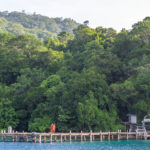
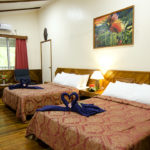
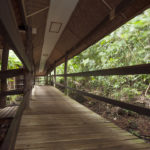
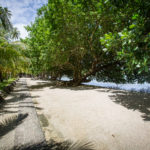
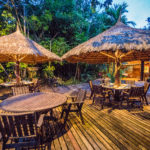
Resort manager Armando Agusto greets us after we make our way up the stairs from the dock to the open-air lobby. We take a look around and do a turn on the broad wooden deck overlooking the Milne Bay oceanfront, a perfect spot for a sundowner. He gives us a brief tour and shows us to our bungalows, which sit on either side of the hillside. Some overlook the bay and main dock; some overlook the sea on the other side of the narrow peninsula. Mine overlooks the bay, and each morning at dawn a dozen or so small dugout canoes piloted by villagers hunt the water for sardines. Armando tells us that dolphins are frequent visitors as well, though I don’t see any during my stay.
We’ve arrived in the early afternoon, assuming our chance to dive for the day has passed. But Armando says differently — after getting settled into our rooms, we can do a checkout dive and a dusk dive on the House Reef. On hearing this, we excitedly finish our (nonalcoholic) welcome drinks and hurry to gear up.
Diving at Tawali
“It’s all about the critters that we have here,” says dive shop manager Alfred George by way of introduction to Tawali diving. He’s right — Milne Bay is especially famous for muck diving and is home to no fewer than six different types of pygmy seahorses.
He’s been the manager for almost 10 years, and the operation’s attention to detail shows. Unlike at most dive resorts, you needn’t set foot in the dive shop at all at Tawali. When we arrive, dive staff gives us bins for our gear and instructs us to leave them outside our bungalows. While we change into our swimsuits, they carry the gear back down the stairs to the dock and set it up on the day boat. There it awaits, ready before we board each morning. We’ll hit a variety of sites during our stay, including the famous Lawadi Bay, filled to the brim with weird and wonderful macro critters. But first it’s time for a checkout dive at Wahoo Point.
At Wahoo, we spend a leisurely 45 minutes cruising along a wall, focused mostly on colorful macro critters like nudibranchs and shrimp. But a surprise awaits — as we near the boat and begin our safety stop, a mobula ray swings by to say hello, swooping and swimming underneath the boat for at least 10 minutes only a few feet away. That will do quite nicely for a checkout dive, I think.
There are typically three dives per day at Tawali — two in the morning and one in the afternoon — and we’re on the schedule for all three the next day. After a buffet-style dinner in the dining room, it’s off to bed early to rest up for our first full day underwater.
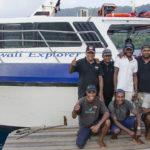
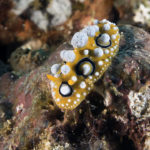
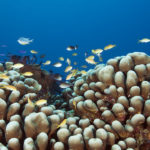
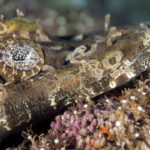
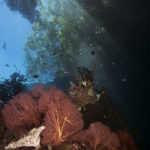
Our day begins at Deacon’s Reef, about a 10-minute boat ride from the resort. It’s a sloping reef shelf that drops off into a wall, which we keep to our left as we cruise along in about 80 feet (25 m) of water. After about 30 minutes it’s time to turn around and shallow up, and that’s when the dive becomes truly spectacular. Fields of healthy hard coral occupy the shallow shelf, which starts at around 50 feet (15 m) and goes all the way up to 15 feet (5 m).
The multi-colored corals are positively swarming with fish — anthias, rainbow runners, jacks, and anemonefish. There are also Moorish idols, butterflyfish and more – clouds so thick it’s like a rainstorm of fish. Bushes of pink whip coral and giant gnome-hat shaped corals hug the rocky limestone coastline, creating all sorts of little swim-throughs, cracks and crevices. It’s like swimming in an aquarium, and I dawdle as much as possible on the way back to the boat.
After a second, equally colorful dive there it’s time for the marquee event: a muck dive at Lawadi Beach. The two sites couldn’t be more different. Where Deacon’s Reef was bright and bustling, Lawadi at first glance seems a bit barren as we begin our descent. It’s a brown, sandy slope, interrupted here and there by small coral patches, but nothing as colorful as Deacon’s Reef. But those who love muck diving know it’s akin to a treasure hunt — Lawadi isn’t going to gaudily display its jewels — we’ve got to hunt for them.
We start in about 60 feet of water and work a grid pattern, letting our guide Albert take the lead. It’s only minutes before the discoveries begin rolling in. Albert finds two seahorses (regular-size, but still), ornate ghost pipefish, Halimeda ghost pipefish, mantis shrimp, an emperor shrimp, harlequin shrimp, an octopus, frogfish — the list goes on. Macro animals allow divers much nearer than large ones, and we spend over an hour underwater, marveling at the intricacies of their tiny bodies.
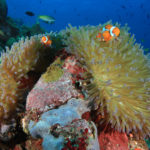
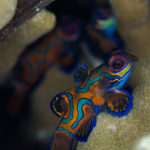
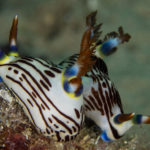

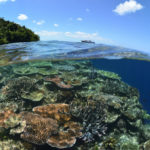
Our second full day underwater begins at Witches Cauldron, another hard-coral wall dive. We begin in about 60 feet of water with the wall to our left and follow a similar profile as with Deacon’s Reef. Because I’ve made it clear to the guides and Alfred that if I don’t see a pygmy seahorse my life will be ruined, on this dive they deliver.
A tiny pink bargibanti pygmy clings to a sea fan along the wall at about 80 feet — if the group would leave me here to stare at it for the entire dive, I would. But continue we must, and we soon shallow up to about 30 feet and into another spectacular hard-coral garden where I see my first epaulette shark — two of them, in fact, sharing real estate under a small coral outcropping. We see a gigantic crocodilefish and a leafy scorpionfish as well before it’s time to reluctantly end the dive.
That evening, I chat with Armando a little more about our dives as we watch the sunset on the deck. Tawali has a little of everything, he says, which is what makes it special. But even after diving some sensational hard-coral sites, my favorite dive of the trip remains Lawadi Beach. That’s unsurprising, he says.
“Muck diving is Milne Bay. Muck diving is Tawali.”
Details
Getting there
Tawali, like much of Papua New Guinea, is quite remote. There are daily flights to Gurney (Alotau) on PNG Air as well as Air Niugini. You must book ahead so that Tawali’s shuttle bus is waiting for you at the airport to take you the 90 minutes to the dock where the resort’s boat awaits.
When to go
Many sites at Tawali are accessible all year thanks to its protected position on the peninsula’s north coast. Still, the very best time to visit is from October through March, when visibility is the best and the skies are relatively calm. Strong winds in February make getting to most dive sites a challenge. If the wind isn’t blowing, you can dive the sites on the south side of the peninsula as well.
What to bring
Tawali offers nitrox diving, so be sure to bring your certification card. Because it’s remote, if something breaks the dive shop may struggle to fix it for you. Thus, it’s smart to bring a save-a-dive kit. Pack any medicine you might need as well since quick run to the pharmacy is impossible.
The post Scuba Diving in Papua New Guinea: Tawali Dive Resort appeared first on Scuba Diver Life.
from Scuba Diver Life https://ift.tt/2RwsFMT
No comments:
Post a Comment